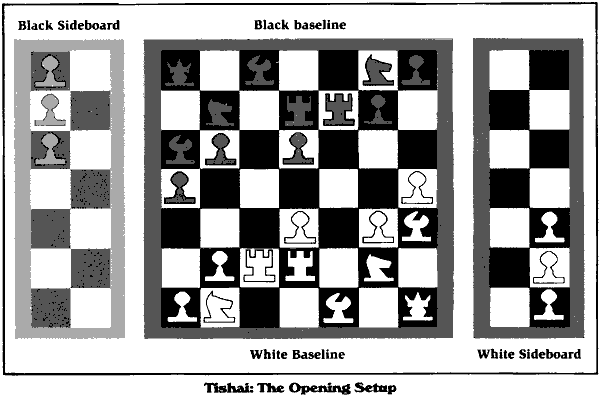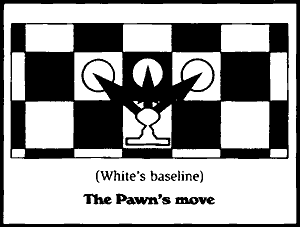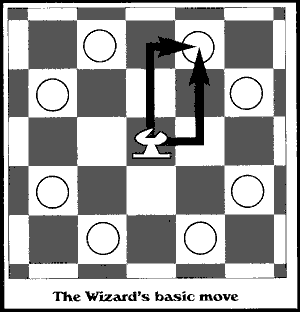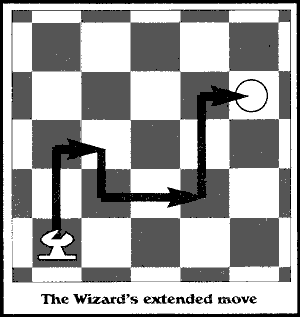Tishai
By James Ernest, Cheapass Games
Posted on the web by the gracious permission of Mr. James Ernest.
Enter a magical new world thats exactly like chess.
History: A magical sword called Tishai ("TEA-shy") was forged to repel a hostile race of demons who invaded the kingdom of Farnac. After the weapon had served its purpose, Tishai became the focus of another war between the king who owned it and the wizard who had created it.
The king was an inventor of games, and during the protracted Demons War he spent his waking hours creating a board game based on his obsession with protecting the sword. The sword was hidden in two secret towers, and could be transported between them by winged courier at a moments notice. The board games objective was to capture both of your opponents Towers.
The kings fears were realized: soon after the Demons War ended, the wizard who created Tishai let the charge to wrest it from the control of the king.
During the Wizards War, the two leaders were also engaged in a prolonged game of Tishai which had begun while the wizard was still in residence at the kings castle. Events in the real world began to resemble the game, to the extent that the king was consulting his game board for tactics.
At a crucial point in the war, the game board began to play by itself.

Tishai, the name of the game, is short for Tishai-Fläk, Farnian for the "Battle of the Sword." It is played on a 7x7 chessboard with two 7x2 sideboards. The sideboards are used for keeping score and storing unused and captured pieces. You can use the pieces from a regular chess set to play Tishai, or you can carve your own pieces out of horn or bone.
* * *
These rules assume some familiarity with the rules of chess. If you are unfamiliar with chess, you may wish to learn that game before tackling Tishai.

To Begin: The diagram on the next page shows the placement of pieces at the beginning of the game. As in chess, White always moves first.
Object: To capture both of your opponents Towers.
You do not need to warn your opponent when you threaten his first Tower, but you must call "check" (or "checkmate") when the second Tower is threatened, or you may not capture it on the next turn.
It is legal, unlike in chess, to move either of your Towers into check. Obviously, you would only endanger your second Tower if you were trying to affect a stalemate.
Stalemate Condition: If White captures Blacks last Tower, and Black can respond by capturing Whites last Tower on the next move, the game is a draw, and neither player wins. (This is not the case when the colors are reversed; the rule is based on the fact that White moved first.)
Movement:
Pawn:

The Pawns are the basic foot-soldiers of Tishai. Five of your Pawns start on the board, but the three others can be brought into play by the actions of Wizards and Towers.
Pawns can move only one space, and can only move forward, either diagonally or straight ahead, as shown in the figure below. Unlike in chess, pawns can move and capture in all of these directions.
If a Pawn reaches the opposite edge, it does not get promoted. It is simply stuck there. This is a problem which must be addressed in chess, but which arises very infrequently in Tishai. Pawns are too desirable as prizes to survive very long.

Knight:
The Knight can move one space in any direction. It can also jump one space in any direction if there is a piece (of either color) for it to jump over. The Knight captures the piece where it stops, not the piece it jumps over. The knight cant jump over an empty space.
Knights Special Moves: On its first move, a Knight can make a double-jump, two jumps in a row, if there are pieces to jump over. This is one extended move, not two moves in a row; in other words, the Knight cant capture something in the middle of its "double-jump." However, the jumps do not have to be in the same direction.
King:

The King can move in all directions, as it does in chess, but to a maximum of three spaces.
Queen:
There is no Queen in Tishai.
Wizard (Bishop):

Late in the game, Wizards will be your most powerful pieces. But at the beginning, they are quite limited.
The Wizard moves in an "L"-shaped path, like the Knight in chess, with two differences: the path must be clear, and the Wizard can sometimes move more than one "L" in one turn.

The Wizards Basic Move: In the figure below, the Wizard can reach any of the marked spaces, provided that a path is clear; either of the "L" shapes shown is a valid path to the marked space. An S-shaped zigzag, on the other hand (up, over, and up) isnt legal.

Moving Further: Once you have captured a few opposing Pawns, your Wizards will become more powerful. The inner lane of your sideboard, shown at right is for tracking the Pawns you have captured. The outside lane of your sideboard is for your own unused Pawns and other captured pieces. For every captured Pawn beyond the first, your Wizards gain an extra segment to their move.
For example, if you have captured three Pawns, as shown here, your Wizards can move up to a triple-L.
Example: A Wizards extended move is shown in the next diagram.

This Wizard is taking a triple move, which means that White must have captured at least three Black Pawns. Note that the Wizard cant capture anything in the middle of this move, only when it finally comes to rest.
Special Rules: When a Wizard is captured, it defects to the other side, becoming a Pawn. If you capture a Wizard, place a Pawn of your own color in the space that your capturing piece just vacated.
Tower:

This piece moves orthogonally, exactly as a Rook does in chess, but to a maximum of three spaces.
Moving into Check: The object of the game is to capture both opposing Towers. Unlike chess, it is legal to knowingly move your Towers into check.
Special Moves: When your first Tower makes its first move, it leaves a Pawn behind to guard the other Tower. Place a Pawn of your color in the space vacated by the Tower.
Weird Rule: If neither of your Towers has moved, you cant use either of them to capture a Wizard. Heres why: The firs Tower that moves leaves a Pawn behind. Similarly, a piece which captures a Wizard will leave a Pawn behind, as described above. If the first Tower that moved were to capture a Wizard, it would leave two Pawns behind in the same space, so the move is deemed illegal.
Strategy: most basic chess strategy still applies in this game. In addition, be careful not to give away too man Pawns unless you have already captured one or both opposing Wizards. Also, the more open the Board becomes, the more easily the Wizards can get around, so be careful exactly where you leave the gaps.
Origins: Tishai (and the infantile storyline which accompanies it) was developed by James Ernest and John Bollinger while the two were in grade school. It was published as Cheapass Game #10 in 1997 and died the terrible slow death a chess variant deserves.
Credits
From "Chief Hermans Holiday Fun Pack"
By James Ernest, Cheapass Games
Posted on the web by permission of James Ernest. (Thanks!)
Words and diagrams retyped by Peter Gelman.
[Note: Ive excluded or changed a few words pertinent only to the paper form, not to the rules themselves.]
Written by James Ernest. Scanning and typing by Peter Gelman.
WWW page created: July 4, 2002.
